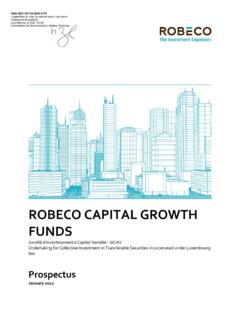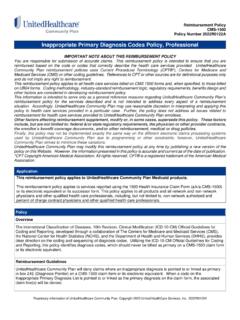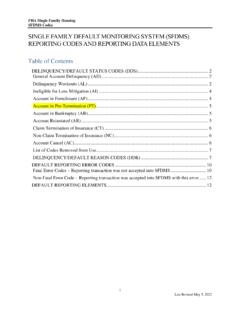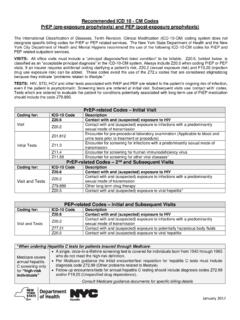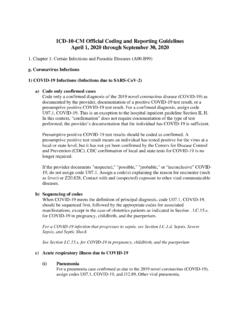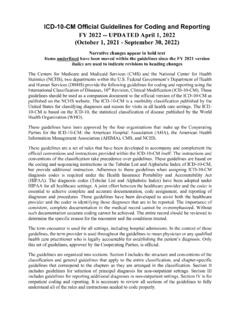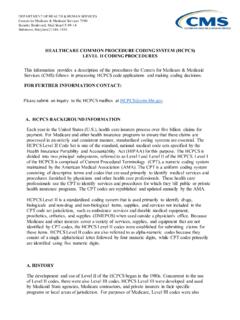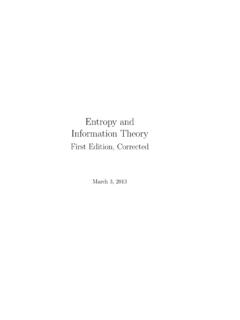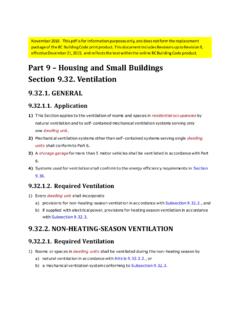Transcription of Principal Adverse Impact Statement - Robeco
1 Principal Adverse Impact StatementROBECO INSTITUTIONAL ASSET MANAGEMENTD ecember 20212 Principal Adverse Impact Contents1. Summary 32. Description of Principal Adverse sustainability impacts 5 Sustainable Investing at Robeco 5 Principal Adverse Impact 5 Planned actions to mitigate Principal Adverse Impact 53. Description of policies to identify and prioritize Principal Adverse sustainability impacts 7 Governance of Principal Adverse Impact 7 Identifying principle Adverse Impact 7 Prioritizing principle Adverse Impact at product level 84. Engagement policies 9 Corporate Engagement 9 Public Policy Engagement 9 Proxy Voting 105. Reference to international standards 11 Approach to Human Rights 11 Approach to Climate change 11 Approach to Biodiversity 12 Appendix: Principal Adverse Impact indicators 13 Principal Adverse Impact 3 1.
2 Summary Principal Adverse impactRobeco acknowledges the responsibility of the asset management industry towards climate change risks and other Principal Adverse impacts through the investment decisions that we make and the contact we have with investee companies and other institutions. The concept of Principal Adverse Impact (PAI) is as follows1: Negative, material or likely to be material effects on sustainability factors that are caused, compounded by or directly linked to investment decisions and advice performed by the legal entity. Under SFDR, Robeco considers 18 mandatory indicators on greenhouse gas emissions, biodiversity, water, waste, and social indicators applicable to companies, sovereigns and supranationals, and real estate assets. In addition, there are 22 additional climate and other environment-related indicators defined, as well as 24 additional indicators related to social factors and employees, respect for human rights, anti-corruption and anti-bribery matters on which reporting and integration is encouraged.
3 Identifying and prioritizing Principal Adverse impactRobeco has a long history of ESG integration and the use of ESG data in its investment processes and has due diligence policies in place to identify and prioritize relevant Adverse impacts and indicators on sustainability factors. The requirements under the SFDR RTS are detailed and require additional ESG data, predominantly on asset-level, that are currently not fully available within Robeco . Robeco has performed an initial data analysis and is in the process of acquiring additional data from external data providers to meet reporting obligations under the EU SFDR. Once the relevant data are available, the methodologies to measure Principal Adverse sustainability impacts can be finalized and will be added to this Statement (expected in Q3 2022). On an entity level, taking into account the available sustainability data, Robeco has identified and prioritized the PAIs and indicators relevant to the organization s overall investment strategy (see table on the next page).
4 If the availability of data improves, more indicators may be Principal Adverse impactRobeco takes both mandatory and non-mandatory Adverse impacts into account in its due diligence procedures in the selection and ongoing monitoring of investments through various methods ranging fromexclusions, reduction of emissions thresholds, voting and engagement, amongst other planned actions. In addition, as an entity, Robeco has joined the Net Zero Asset Manager Initiative and signed the Finance for Biodiversity Pledge, which are relevant to mitigating potential Adverse Impact as a company. The actions Robeco has taken to avoid and reduce Adverse sustainability impacts are reported on in our annual Sustainability Report which can be found on our website. As of Q3 2022 reporting will be presented via the template related to PAI reporting as referred to in the ESA s final report on the SFDR regulated technical standards2.
5 1. JC 2021 034 Principal Adverse Impact Table 1: Overview of current PAIs identified ScopeThemePAI indicatorTableNumberInvestee companiesClimate and other environment- related indicators GHG emissions11 Carbon footprint12 GHG intensity of investee companies13 Exposure to companies active in the fossil fuel sector14 Exposure to companies active in the fossil fuel sector15 Energy consumption intensity per high Impact climate sector16 Activities negatively affecting biodiversity sensitive areas17 Emissions to water18 Hazardous waste ratio19 Investing in companies without carbon emission reduction initiatives24 Natural species and protected areas214 Social and Em-ployee, Respect for Human Rights, Anti corruption and Anti Bribery matters Violations of UN Global Compact principles and Organisation for Economic Cooperation and Development (OECD)
6 Guidelines for Multinational Enterprises1 10 Lack of processes and compliance mechanisms to monitor compliance with UN Global Compact principles and OECD Guidelines for Multinational Enterprises1 11 Unadjusted gender pay gap112 Board gender diversity113 Exposure to controversial weapons (antipersonnel mines, cluster munitions, chemical weapons and biological weapons)1 14 Excessive CEO pay ratio 38 Sovereigns and Supranationals Climate and other environment- related indicators Share of bonds not certified as green under a future EU act setting up an EU Green Bond Standard2 17 GHG intensity 115 Social and Employee, Respect for Human Rights, Anti corruption and Anti Bribery mattersInvestee countries subject to social violations 1 16 Real Estate Fossil fuels Share of investments in real estate assets involved in the extraction, storage, transport or manufacture of fossil fuels1 17 Energy efficiencyShare of investments in energy-inefficient real estate assets118 Principal Adverse Impact 5 IntroductionAs of 1 July 2022, Robeco will describe in this section Adverse impacts that qualify as Principal .
7 As well as the actions planned or targets set for the first reference period to avoid or reduce Principal Adverse Impact . For now, the following paragraphs aim to provide an introduction to how Robeco plans to set targets and integrate Principal Adverse sustainability impacts, given that sustainability is an essential component of Robeco s 2021-2025 strategy. This strategy includes, but is not limited to, the following:- In line with our Net-Zero Commitment, we have established an ambitious climate strategy, including a decarbonization trajectory and forward-looking indicators. Interim carbon reduction targets have been communicated, aiming for an average of 7% reductions on portfolio level per annum, to help meet our net-zero 2050 ambition. Initially confined to Robeco funds only, the scope of our decarbonization strategy will gradually increase to include client mandates and reach 100% of AUM.
8 The targets are set on portfolio level, not on individual fund Biodiversity loss will have a large Impact on the ability of companies to produce food at the current scale of production. In line with the Finance for Biodiversity Pledge, Robeco will have assessed its individual biodiversity footprint, set targets and report on progress against these biodiversity targets by 2024 the latest. In addition, Robeco will continue to collaborate and engage with stakeholders, continuing to develop thought leadership, and building on the knowledge gained in advocating for sustainable palm oil production. - Robeco embraces doing no significant harm to the Sustainable Development Goals in its operations and in its asset management s current approach to doing no significant harm, and thereby mitigating negative Impact , allows for the integration of Principal Adverse Impact , as introduced by the EU SFDR Framework, in our investment processes.
9 Principal Adverse Impact The concept of Principal Adverse Impact (PAI) is described in the EU Regulation on sustainability-related disclosures in the financial services sector (SFDR)3. The definition of PAI is as follows: Negative, material or likely to be material effects on sustainability factors that are caused, compounded by or directly linked to investment decisions and advice performed by the legal entity. More concretely, the SFDR framework will require the consideration of 18 mandatory indicators on greenhouse gas emissions, biodiversity, water, waste, and social indicators applicable to companies, sovereigns and supranationals, and real estate assets. In addition, there are 22 additional climate and other environment-related indicators defined, as well as 24 additional indicators for social and employee, respect for human rights, anti-corruption and anti-bribery matters on which reporting and integration should be determined based on the materiality of the financial entity s investments and availability of Planned actions to mitigate Principal Adverse impactRobeco takes Principal Adverse impacts into account in its due diligence procedures for investment selection and ongoing monitoring.
10 Principal Adverse Impact is also taken into account through various methods such as exclusions, reduction of emissions thresholds, and voting and engagement. In addition, as an organization, Robeco has made several commitments related to 2. Description of Principal Adverse sustainability impacts 3. Principal Adverse Impact climate change and biodiversity, amongst other topics, which are relevant to mitigating potential Adverse Impact as a company. These approaches are explained in the following paragraphs. Robeco acts in accordance with applicable regulation and aims to lead in the implementation of relevant Stewardship codes. More information can be found on our approach to the Shareholder Rights Directive II as well as in in our Stewardship Policy. More detailed descriptions on Robeco s strategy to address PAI indicators will be provided by July to address principle Adverse impactMethodExplanationExample More information Exclusions Robeco believes that some prod-ucts and business practices are detrimental to society and in-compatible with sustainable investment strategies.


